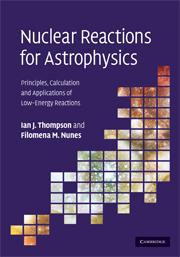Book contents
- Frontmatter
- Contents
- Preface
- Sources of quotations
- Acknowledgements
- 1 Nuclei in the Cosmos
- 2 Reactions of nuclei
- 3 Scattering theory
- 4 Reaction mechanisms
- 5 Connecting structure with reactions
- 6 Solving the equations
- 7 Approximate solutions
- 8 Breakup
- 9 Three-body nuclei
- 10 R-matrix phenomenology
- 11 Compound-nucleus averaging
- 12 Stellar reaction rates and networks
- 13 Connection to experiments
- 14 Spectroscopy
- 15 Fitting data
- Appendix A Symbols
- Appendix B Getting started with Fresco
- Select bibliography
- Index
8 - Breakup
Published online by Cambridge University Press: 05 March 2012
- Frontmatter
- Contents
- Preface
- Sources of quotations
- Acknowledgements
- 1 Nuclei in the Cosmos
- 2 Reactions of nuclei
- 3 Scattering theory
- 4 Reaction mechanisms
- 5 Connecting structure with reactions
- 6 Solving the equations
- 7 Approximate solutions
- 8 Breakup
- 9 Three-body nuclei
- 10 R-matrix phenomenology
- 11 Compound-nucleus averaging
- 12 Stellar reaction rates and networks
- 13 Connection to experiments
- 14 Spectroscopy
- 15 Fitting data
- Appendix A Symbols
- Appendix B Getting started with Fresco
- Select bibliography
- Index
Summary
In science one tries to tell people, in such a way to be understood by everyone, something that no one ever knew before. But in poetry, it's the exact opposite.
Paul DiracNuclei close to the driplines have large breakup cross sections. The breakup mechanism connects a bound state of the projectile with its continuum states, so the process is rather similar to inelastic excitation, except that the final state is unbound. If the target has a strong Coulomb field, then breakup reactions measure the electromagnetic response that populates scattering states. These can be relevant for astrophysical processes either directly, in photo-disintegration, or in reverse, for capture reactions. The excitation into the continuum also allows the study of resonances, and this is important for structure studies because the understanding of the spectra of unstable nuclei depends strongly on resonant properties. Because of these many interests, it is important to establish reliable models for the description of breakup reactions. For simplicity we shall neglect target spin in this chapter. The connections to astrophysics and nuclear structure will be considered in Chapter 14.
In the simplest case, breakup will leave the target nucleus in its ground state. This is called elastic breakup (also called diffraction dissociation). However, there are experiments that measure the inclusive reaction, and then inelastic breakup (also referred to as stripping) can be an important contribution. Elastic breakup of a two-body projectile can be modeled as a three-body problem, and this is the approach presented in Sections 8.1 and 8.2. Later in subsection 8.3.2 we discuss methods for inelastic breakup.
- Type
- Chapter
- Information
- Nuclear Reactions for AstrophysicsPrinciples, Calculation and Applications of Low-Energy Reactions, pp. 254 - 273Publisher: Cambridge University PressPrint publication year: 2009

